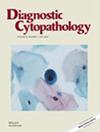Utility of Proliferation Markers Ki-67 and PHH3 in Predicting Malignancy in Basaloid Salivary Gland Neoplasms: A Study Using Digital Image Analysis of Cytology Cell Blocks
Abstract
Introduction
Basaloid salivary gland neoplasms (BSNs) are notoriously difficult to classify in fine needle aspiration (FNA) specimens due to the morphologic overlap of benign and malignant entities. Adenoid cystic carcinoma (AdCC) represents a particular diagnostic challenge, as it typically shows low-grade cytologic features despite its aggressive clinical behavior. We examined whether the proliferation markers Ki-67 and PHH3 could help predict malignancy in BSNs.
Methods
A retrospective search was conducted to identify FNA cases of BSNs that had adequate tumor cellularity in the cell block and a subsequent excision specimen. Ki-67 and PHH3 immunohistochemical stains were performed. Aperio (Leica Biosystems) was used to calculate the percentage of tumor cell nuclear expression. Proliferation scores and final histopathologic diagnoses were correlated using a two-sided p-value test.
Results
Ten benign and 14 malignant basaloid neoplasms were analyzed. Benign cases showed low mean percentages of tumor cell staining for Ki-67 (1.14%) and PHH3 (0.84%), while malignant cases showed significantly higher mean percentages, especially with Ki-67 (19% for low-grade malignancies and 25.5% for high-grade malignancies). The difference in proliferation marker scores between the benign and low-grade malignant cases showed statistical significance for both Ki-67 (p = 0.0041) and PHH3 (p = 0.00397). The difference between benign entities and AdCC was also statistically significant for Ki-67 (p = 0.0013) and PHH3 (p = 0.002).
Conclusion
Ki-67 and PHH3 analysis in cell block material may help predict malignancy in a cytologic specimen from a BSN, offering a valuable ancillary tool for cases with cytomorphologic ambiguity. In particular, the ability to suggest a sample is more likely to be AdCC rather than another morphologically similar low-grade BSN would be helpful for surgical planning.


 求助内容:
求助内容: 应助结果提醒方式:
应助结果提醒方式:


